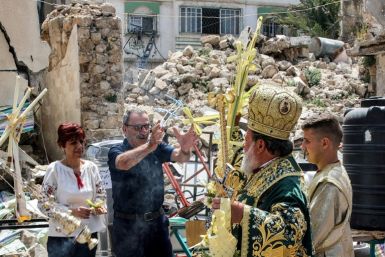ISIS' Looting Of Precious Relics In Syria 'Biggest Threat' To Art Since World War II

Precious relics and artifacts stolen by ISIS in territories they have taken are now in the hands of collectors in the Gulf states. Artworks, statues, coins and manuscripts of religious and cultural significance were among the antiquities ISIS pilfered in Iraq and Syria.
ISIS militants have targeted world heritage sites in the ruins of Syria’s Palmyra, Crac des Chevaliers and Aleppo’s medieval structures. The Independent reports that the looting of ancient relics represents the “biggest threat” to heritage sites since World War II. The demolition of some relics like Raqqa’s 2,800-year old Hittite sculptures has alarmed art experts.
Robert Jenrick, the British MP for Newark, will be urging to ministers to apply diplomatic pressure on countries in the region to end the trade of stolen artifacts. Middlemen sell many of the relics to wealthy art collectors in the Gulf region. Jenrick said a tougher action is needed against an illicit trade that only helps ISIS militants buy more weapons. He claimed that the proceeds are also linked to drug and people trafficking and drugs.
He told The Independent that the royal families in the Gulf nations have declared their love for the arts and museums but turned a blind eye on illicit trade. Jenrick said ISIS was using its networks under the regime of Saddam Hussein to move weapons, drugs and people out of the region. The British MP added that ISIS had reportedly claimed 20 percent of profits from the sales of all relics.
Jenrick said that some items were stolen by groups loyal to Syrian President Bashar al-Assad as well as other people driven to loot for food and money. He said artworks for sale can be found in markets near the Turkish-Syrian border.
Meanwhile, ISIS continues to spread its propaganda videos. Following the cinematic production of the video featuring the Jordanian pilot’s horrific murder, a new footage shows the brutal killing of another prisoner believed to be from Syria. The Daily Mail reports that the prisoner was killed with one shot at the back of the head at point-blank range.
In the video, the prisoner can be seen wearing the orange jumpsuit that Western hostages are forced to wear before their execution. The ISIS militant can be seen ranting behind the prisoner before he catches a shotgun thrown to him by a person not seen in the camera.
The militant fires a single shot moments later while the prisoner remains kneeling. The film goes into playback and replays the moment the bullet hit the back of the prisoner’s head in slow motion. The next scene showed the Syrian prisoner’s dead body in a pool of blood.
To report problems or leave feedback on this article, contact: r.su@ibtimes.com.au






